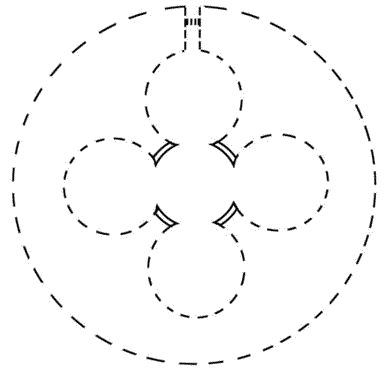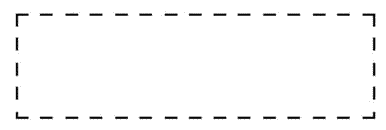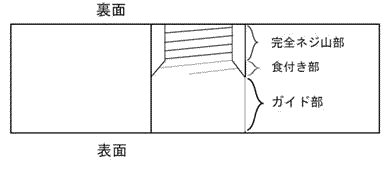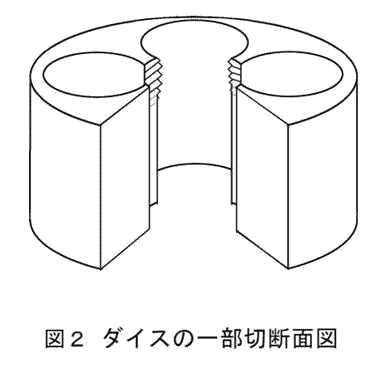| 閉じる | |
| 【意匠に係る物品】ダイス 【意匠分類】K1−403 【国際意匠分類】 Loc(13)Cl.8−05 【Dターム】K1−403VZA 【創作者】 【氏名】石堂 伸夫 【住所又は居所】兵庫県神戸市東灘区向洋町中1-2-19 【意匠権者】 【識別番号】522411544 【氏名又は名称】石堂 伸夫 【住所又は居所】兵庫県神戸市東灘区向洋町中1-2-19 【代理人】 【識別番号】100166589 【弁理士】 【氏名又は名称】植村 貴昭 【意匠に係る物品の説明】 本物品は、ガイド付きダイスである。ダイス本体のネジ切リ穴のネジ切リ開始位置(深さ)を、ダイス表面とするのではなく、ダイス表面からガイド部分と称する、ネジ切り被加工物と同径でネジ切リをしない被加工物の導入部分の深さを設けて、ネジ切リ開始位置をダイス穴の途中の深さに設定することにより、被加工物とダイスとの密着性を利用して、ネジ切リ開始時のダイス中心軸と被加工物の中心軸とを一致させること、即ち両軸一致性を容易に確保できることを意匠の特徴とするダイス。 【意匠の説明】 実線で表した部分が、意匠登録を受けようとする部分である。より具体的には、参考断面図1で記載している、ガイド部、食いつき部、完全ネジ山部の部分が実線部である。右側面図、左側面図は正面図とほぼ同一であるため省略する。また、底面図も平面図と同一であるため省略する。 【参考文献】製品紹介 ’05 TAPS and DIES、26頁、(特許庁意匠課公知資料番号 HC17055906 ) 【参考文献】TRIUMPHTWISTDRILLCO.、53頁、(特許庁意匠課公知資料番号 HD05019143 ) |
|
【平面図】 |
【正面図】 |
【背面図】 |
【参考断面図1】 |
【参考断面図2】 |
|
金属棒の外端部にネジを切る工具であるダイスの形状に関する意匠登録です。被加工物である金属棒にダイスでネジを切る際に、最初に被加工物の中心軸とダイス穴の加工軸とを正確に一致させる必要があります。この両軸一致がなければネジ切りが不適切に進行し、場合によっては途中で中断を迫られる場合があります。両軸一致を実現するために、従来のダイスでは慎重な手技であったり他の機器でガイドをしたりする必要がありました。意匠登録したダイスはダイス本体のネジ切リ穴のネジ切リ開始深さをダイス表面とするのではなく、ダイス表面からガイド部分と称する、ネジ切リをしない被加工金属棒の導入部分の深さを設けます。ネジ切リ開始位置をダイス穴の途中の深さに設定することにより、ネジ切り開始までの被加工物の長さ分のダイスとの密着性を利用して、ネジ切リ開始時のダイス中心軸と被加工物中心軸の両軸一致性を容易に実現します。この両軸一致の確保容易性を意匠の特徴とするダイスです。ネジ切り開始時にダイス面を適切にするための手技に要する手間や他の機器によるガイドの必要がなくなり両軸不一致による不良加工を防ぎながらネジ切り工程時間を短縮できます。 |
|
| This design registration relates to the shape of a die, which is a tool for threading the outer end of a metal bar. When threading an altered metal bar, it is first necessary to precisely align the center axis of the workpiece with the machining axis of the die hole. Without this alignment, threading will proceed improperly, and in some cases, the process may have to be interrupted. In order to achieve biaxial alignment, conventional dies require careful manual manipulation or guiding with other equipment. In the design registered die, the threading start depth of the threading hole in the die body is not set at the die surface, but at a depth from the die surface to the guide portion, where the metal rod to be machined is introduced without threading. By setting the threading start position at the depth in the middle of the die hole, it becomes easy to achieve the consistency between the center axis of the die and the center axis of the workpiece at the start of threading by utilizi ng the adhesiveness of the workpiece with the die for the length of the workpiece until the start of threading. The design of this die is characterized by the ease with which both axes can be secured. The time required for the threading process can be shortened while preventing defective threading due to mismatch between the two axes, eliminating the need for manual work to ensure proper die surface alignment at the start of threading and the need for guiding by other equipment. | |
| ページtop へ |